DISPATCH: After Russian Occupation, One Ukrainian Village Starts Picking Up the Pieces
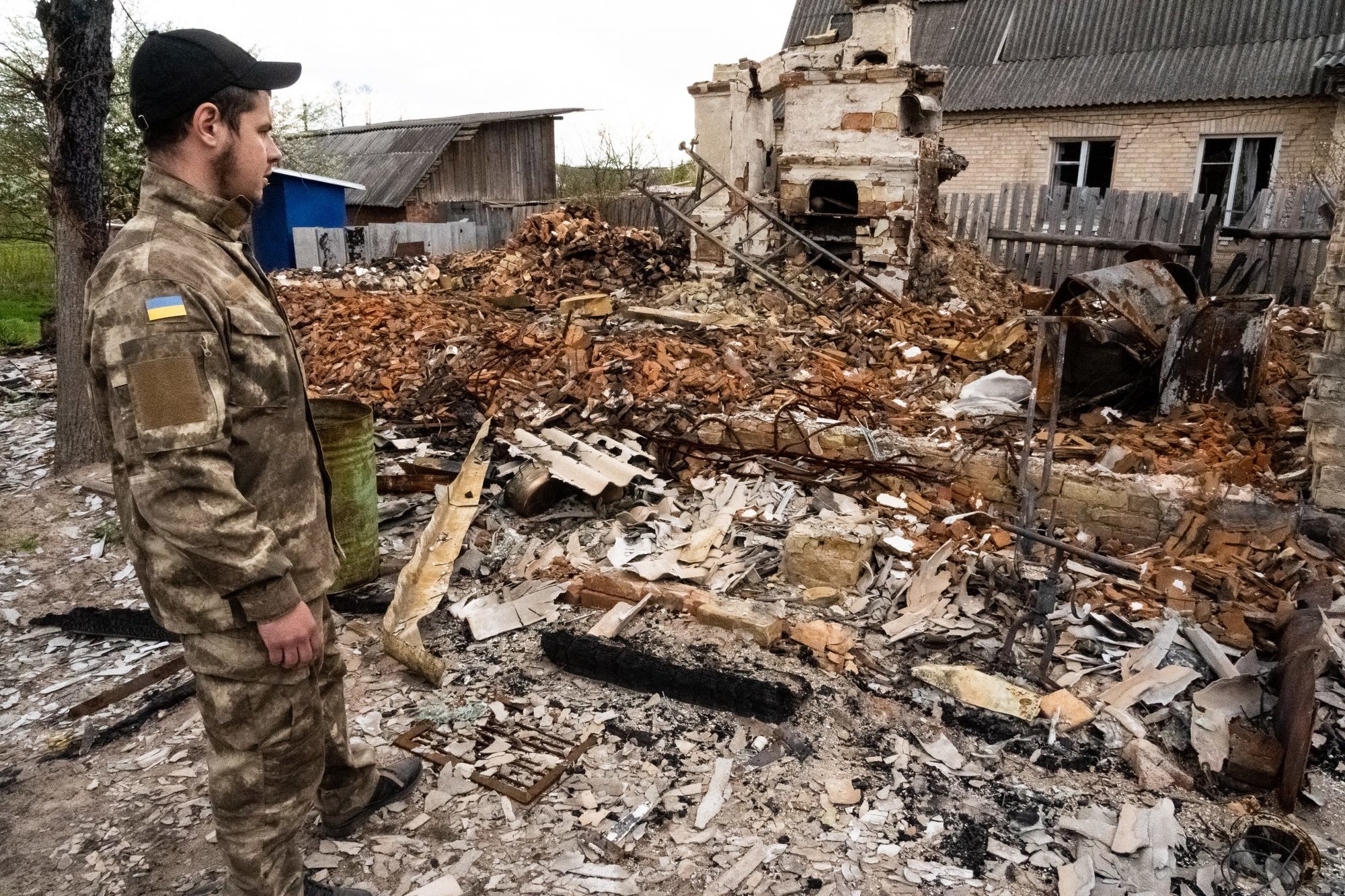
Valeriy, a Territorial Defense soldier, observes his ruined home in Moshchun, Ukraine. Photo by Nolan Peterson/Coffee or Die Magazine.
MOSHCHUN, Ukraine — The destruction is offensive. It violates your vision. You try to look away and find some safe place to rest your eyes. But there is none.
No building left untouched. Some with only a wall or two caved in from the explosions; others reduced to piles of scorched rubble and twisted metal. All windows are shattered. Shrapnel wounds pockmark practically every vertical surface. Trees, snapped in half and charred like used matchsticks. Craters often interrupt the dirt roads. Endless, street after street.
“It was hell on earth,” says Valentina Fursa, a 67-year-old woman who spent 11 days in a cellar with her neighbor, Olena, while Russian artillery and airstrikes pounded the earth above. One morning, Fursa peeked outside from her underground sanctuary and saw Russian soldiers patrolling her street.
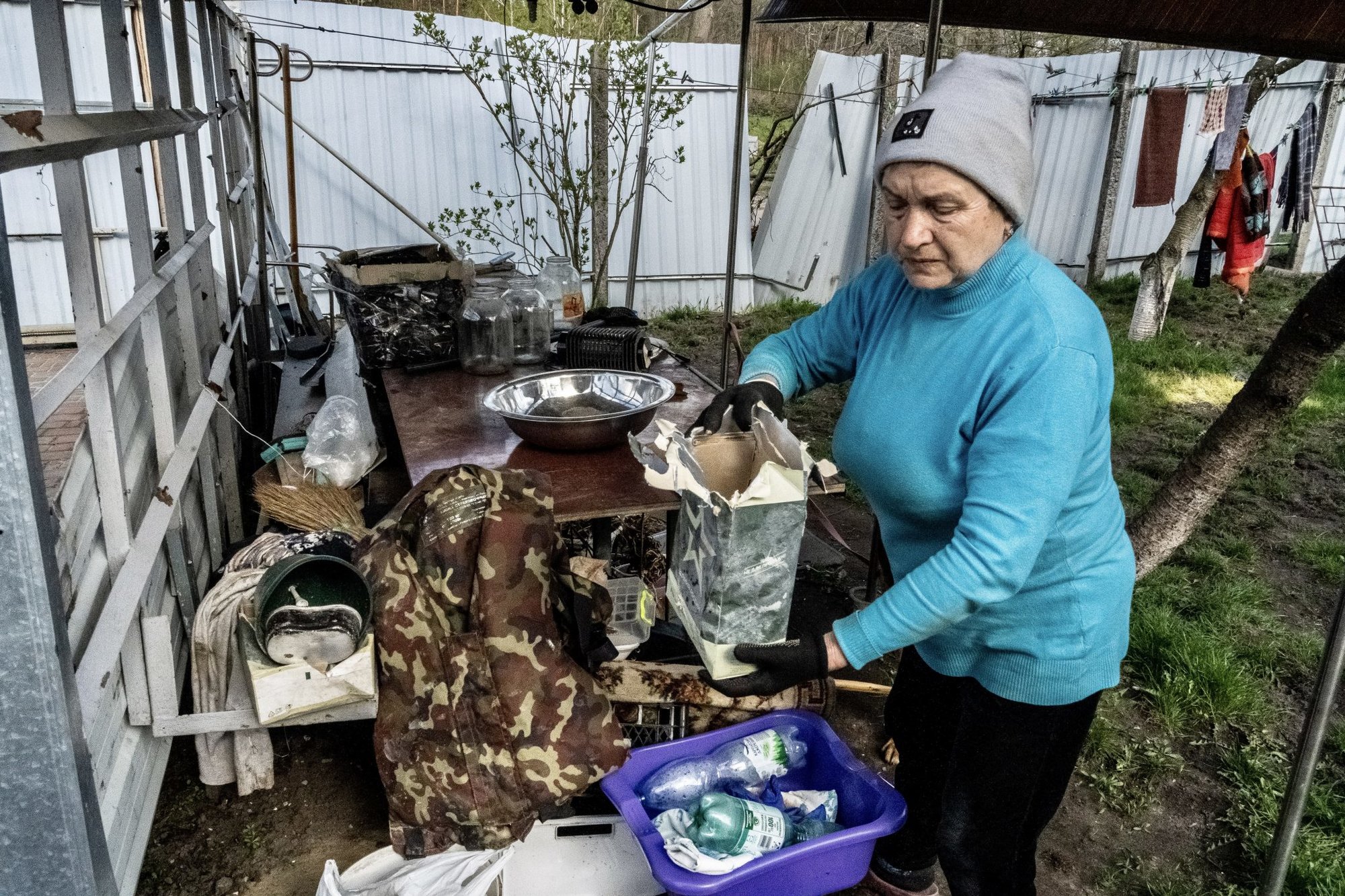
“You can’t imagine the fear,” she tells me.
On this day at the end of April, Ukrainian flags once again fly over Moshchun, and ruined Russian equipment blights the nearby woods. Even so, Fursa still needs tranquilizers to sleep.
“The pills don’t help with my nightmares,” she says.
Nestled within a wooded area just to the north of Kyiv, Moshchun was home to about 1,000 people before Russia’s full-scale invasion of Ukraine began on Feb. 24. Today, about 40 or 50 residents remain or have returned to Moshchun since Russian forces withdrew from the village on March 30, following 20 days of occupation.
About a month after the Russians left, Moshchun remains a war-torn wasteland. Within piles of blasted brick and concrete and twisted rebar lie the remains of burnt and blown-apart vehicles. Stripped of all paint, the vehicles’ bare metal skeletons have been oxidized by fire and look old and rusted.

“This was a brand-new car,” Valeriy says, gesturing toward the scorched automobile carcass in his front yard.
A 51-year-old soldier in Moshchun’s Territorial Defense unit, Valeriy saw the worst of Russia’s onslaught. Standing in the debris field that his front yard became, he shows me a picture of his house before the war. The smartphone photo reveals a handsome, hand-built structure made of tan bricks and surrounded by greenery. Today, Valeriy’s home exists as a pile of rubble, bleached white by what he claims was a Russian white phosphorus munition. He’s lost everything. When I ask if he will rebuild, Valeriy says nothing and shrugs his shoulders.
Weaving through the wreckage, we arrive at a field where Valeriy used to grow vegetables. Russian artillery and bombs have left perfectly formed craters in the soft, dark earth. This once fertile ground is now too dangerous to tread upon. I scoot around the lip of one crater to get the lighting right for a photo, and Valeriy shouts for me to stop. He gestures behind me toward a Russian booby trap.

My eyes search for a moment, and then at last I see a small piece of fabric, seemingly suspended in space, which Ukrainian troops have tied to the thin, nearly invisible filament spanning the yard.
“This isn’t a war, this is genocide,” Valeriy says.
He then shows me the shrapnel hole in his passport, which he’d kept tucked in a front pocket on his body armor vest. The shot did not wound him but was one in a series of “what if” moments that marked the narrow boundary between life and death in combat.
“I survived because I was lucky, that’s all,” Valeriy says.

The war maintains its ability to inflict random, purposeless death, even after the invading Russian army has departed. All day, explosions thunder through Moshchun as Ukrainian sappers detonate unexploded ordnance. The few locals who have returned home say that at night they hear explosions set off by wild animals stumbling over mines and other explosives.
When Russian ground forces advanced on Kyiv at the end of February, a die-hard band of about 50 Territorial Defense soldiers defended Moshchun as long as they could. At first, they prioritized the evacuation of civilians. Then they dug in and faced Russia’s bombardments. These Ukrainian troops were all volunteers. Some were veterans of the 8-year-old war in the Donbas. Others had no military experience at all.
Beginning around Feb. 25, Ukraine’s regular army supplied Moshchun’s Territorial Defense troops with weapons — mostly small arms. Even so, some of these volunteer troops used personal hunting weapons against the Russian invaders who pummeled Moshchun with artillery, airstrikes, missiles, and tank shots. Russian units grinded their way ahead and incrementally laid waste to this small Ukrainian village they intended to occupy.
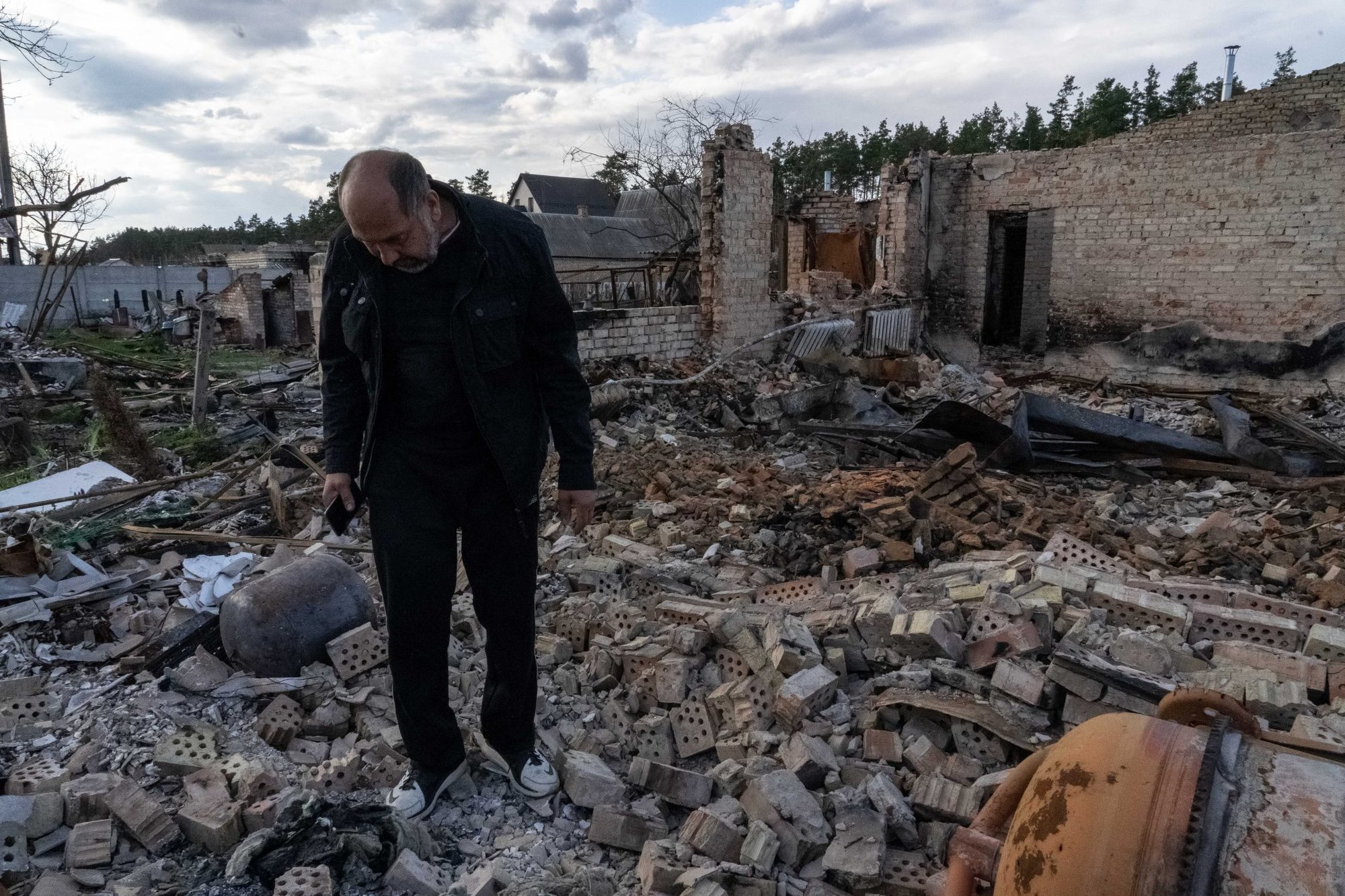
Valeriy leads me along a dirt road. He pauses and points out a small pile of tattered clothing beside a massive bomb crater. The clothing belonged to his friend, Oleksandr Topal. Valeriy explains that Topal died during a Russian artillery barrage on March 4. The heat and force of the blast warped the twin metal barrels of the hunting shotgun Topal held.
Valeriy, who was at a nearby Ukrainian checkpoint just up the road at the time, says he watched Topal die. Afterward, Valeriy collected what was left of his 34-year-old friend in a plastic bag.
“It was very hard. Very hard to lose a friend,” Valeriy says.
Russia’s invading ground forces had their sights set on Kyiv when the full-scale invasion began on Feb. 24. Yet, after about two weeks of back-and-forth fighting, they weren’t able to establish a foothold in Moshchun until March 10. The nearby village of Horenka, about a five-minute drive away, never fell to the Russians.
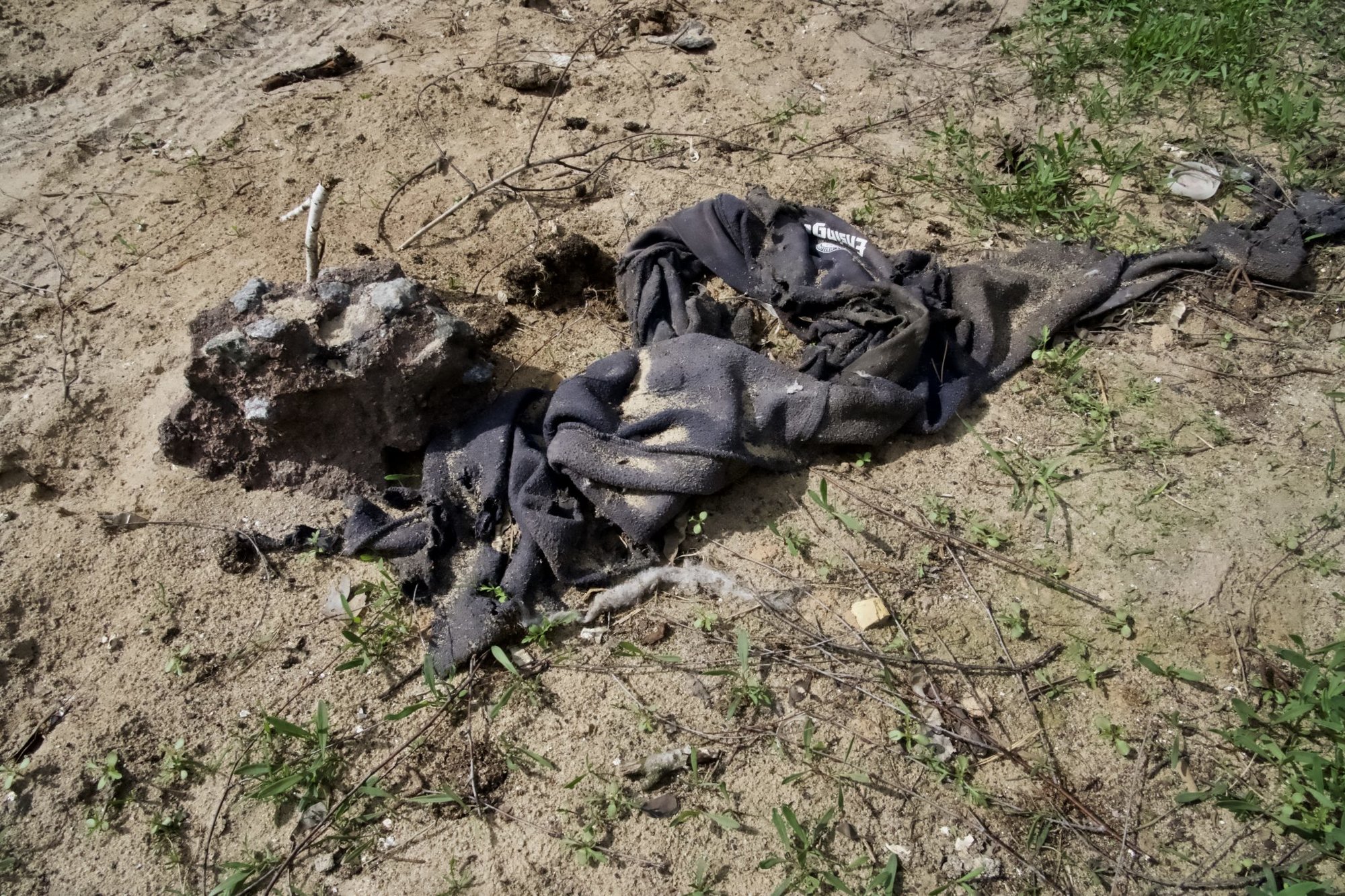
“I wouldn’t even call it territorial defense, I’d call it self-defense,” says a 31-year-old Territorial Defense soldier from Moshchun also named Valeriy (who is of no relation to his 51-year-old comrade in the same unit). “They came to our land to kill our relatives, to kill us. And we had a feeling of unity. We had to fight back.”
In other villages and settlements surrounding Kyiv, similar acts of stalwart local resistance, along with the Ukrainian regular army’s artillery support and anti-tank patrols, stalled the Russian advance in its tracks and ultimately spared the center of Kyiv from all-out urban combat.
By March 10, nearby Ukrainian regular units instructed Moshchun’s Territorial Defense soldiers to evacuate. Moshchun’s defenders had done their job and risked being overrun if they held out any longer.
“We didn’t want to leave. We had to drag some guys away, but it was war. We had to go,” the younger Valeriy says while he leads me farther up Moshchun’s main dirt road.
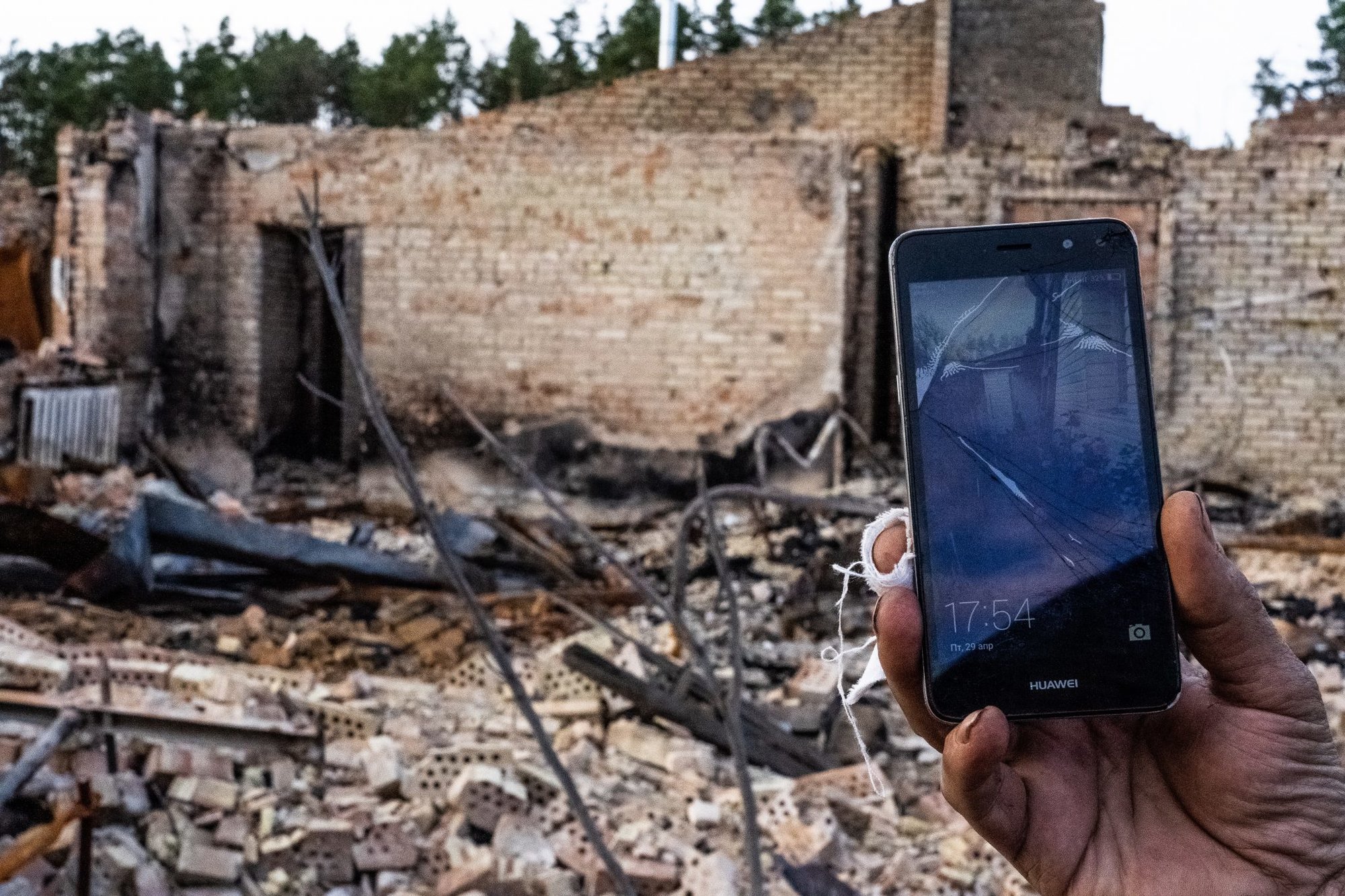
We walk past row after row of ruined homes. The younger Valeriy gestures toward one pulverized plot and says that an elderly couple, Olha and Oleg Mokushenko, died inside the rubble. A little farther along the road, we arrive at what’s left of Valeriy’s home — basically, a brick pile. The metal stove was the sole item that mostly survived.
Valeriy leads me through the rubble to his backyard. We walk up to the lip of a large crater, which he says an aerial bomb made. Rainwater mostly fills the depression.
“Thanks to the rashists, I now have a custom lake in my backyard,” Valeriy says with a sly grin, using a popular term in Ukraine these days that combines the words “Russian” and “fascist.”
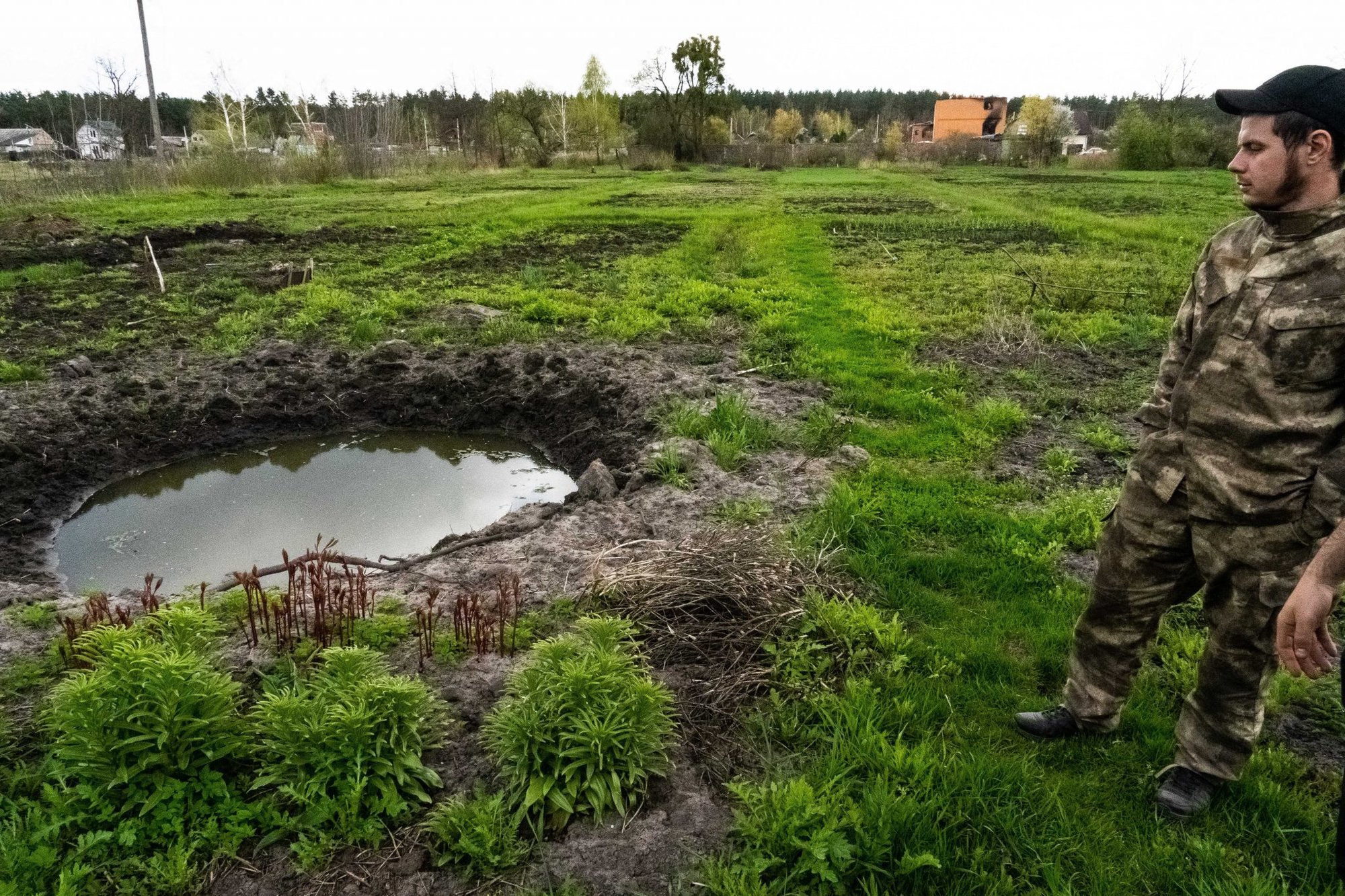
When the full-scale war began, the younger Valeriy evacuated his wife and child to safety and then returned to Moshchun and served in its defense.
“I didn’t have time to take any toys,” he says.
A regular army combat veteran who had already served for one and a half years on the Donbas front lines, Valeriy felt it was his duty to also fight against the full-scale invasion. The brutality and intensity of combat he endured in his own village far surpassed his experience in the Donbas trenches. He vividly remembers how the sky glowed blood red at night from the encompassing, encroaching infernos.
“This time was more intense, more bloody, and more total. This time the Russians killed civilians on purpose. It was wanton violence and total chaos here,” Valeriy tells me.
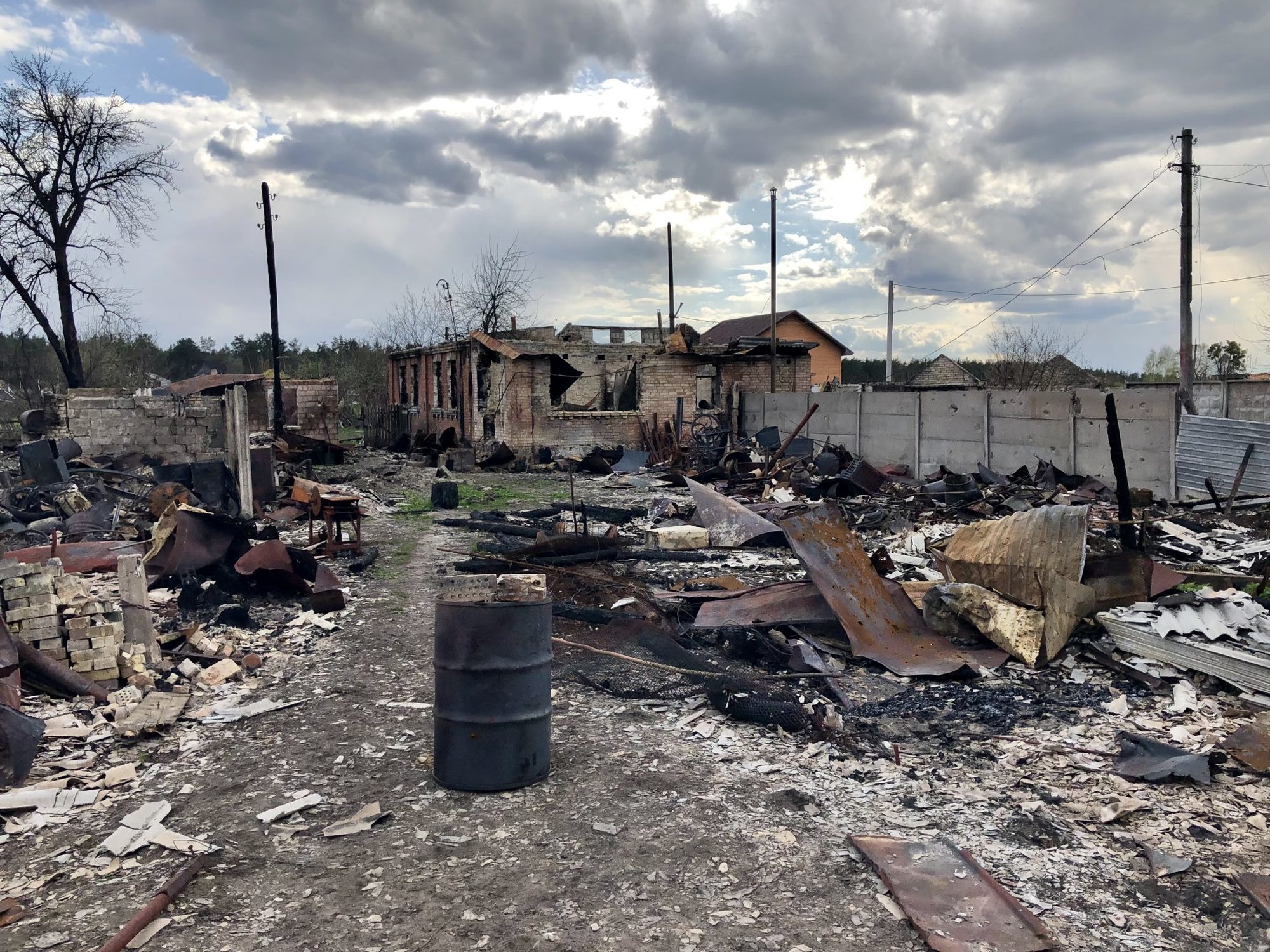
When I ask if he will rebuild, Valeriy says it’s too soon to think about resuming his peacetime life.
“The war isn’t over,” he says. “It’s still dangerous here.”
We continue up the road past a home that, in contrast to its surroundings, stands largely intact. Gathered out front along the street are Natalya and Alexander Dumenko, and their two children — 5-year-old Vladislav and 2-year-old Diana. Behind the foursome, an abstract arrangement of shrapnel holes scars the metal siding of their home’s front gate.
Alexander smokes a cigarette, and the children play in a wheelbarrow while Natalya explains that the family retreated into their cellar when the full-scale invasion began.
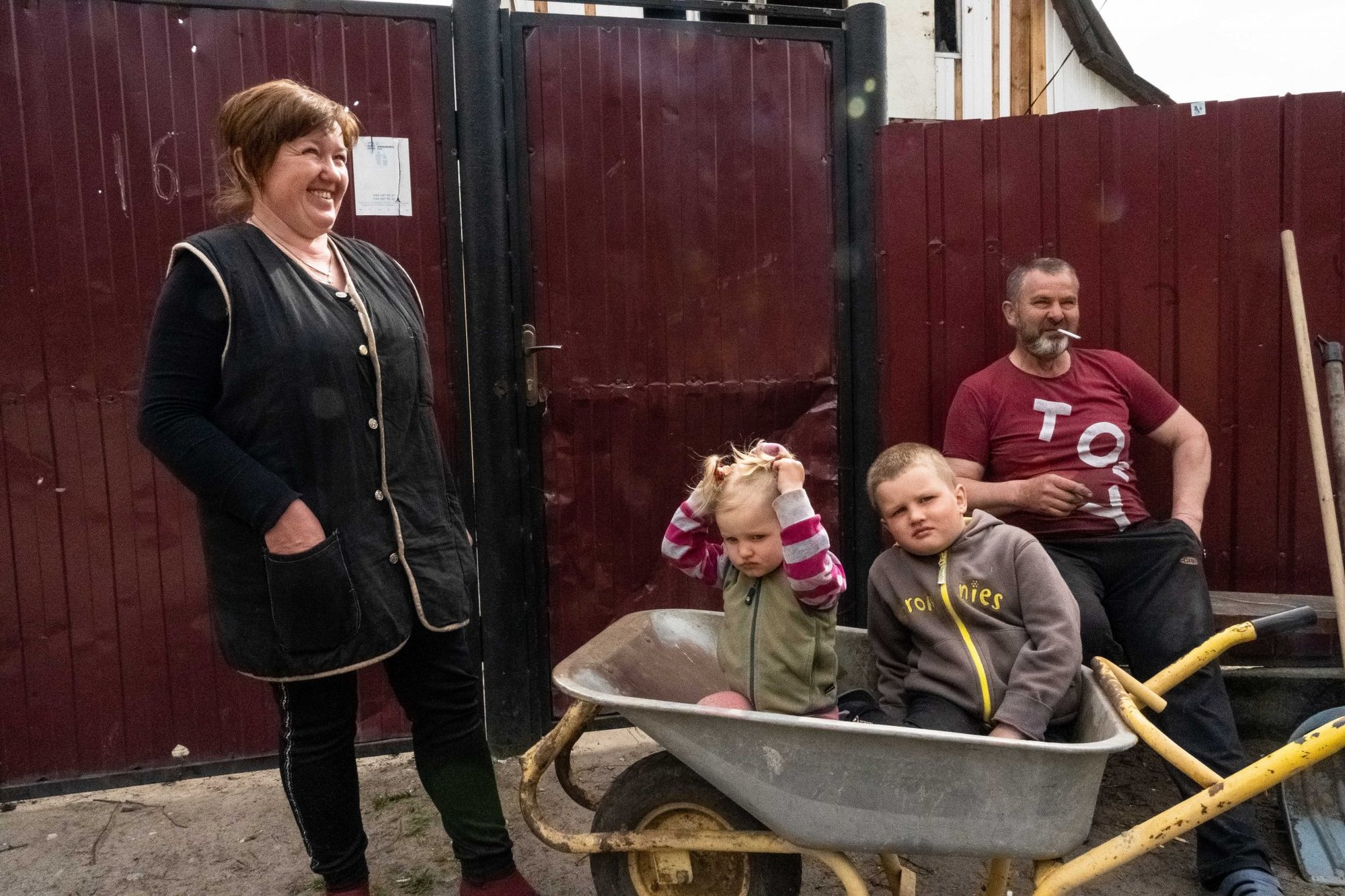
“We thought maybe it would end in a few days,” Natalya says. “We were wrong. For 11 days we hid in the basement. During the first days of the war, there were helicopters, airplanes, artillery, and Russian tanks came into the village. It was too dangerous to leave.”
The Dumenkos left Moshchun on March 6 in their Lada Niva SUV. The Soviet-era SUV had somehow survived the aboveground maelstrom.
“It was terrifying to drive with the artillery,” Natalya says.
Following a few minutes of street-side conversation, the Dumenkos invite me to observe their home. They’d returned on April 27 and were eager to pick up the pieces of the life they’d abandoned under Russian occupation. They draw fresh water from a well but remain without electricity or gas. Cellular reception is a bit spotty, too.

Part of their home was destroyed, leaving a pile of rubble in their courtyard. But, by and large, the Dumenko family was relatively lucky compared with their neighbors — they’re able to live with a roof over their head in the undamaged portion of their residence. Moreover, they have a farm with some 25 pigs and a crowded chicken coop, and most of the animals survived. The greatest relief, however, was the survival of their two cats, Murik Sr. and Murik Jr.
Vladislav had worried about the cats while Russian soldiers occupied Moshchun and the family was away. When the Dumenkos returned home more than a month later, they happily discovered that both cats had survived. Although the elder Murik had a small wound to his front left paw, the cats seemed to be fine.
These days, the family is consumed with the daily chores of rebuilding their home. Alexander explains that the work, albeit tiresome, is a healthy distraction from the apocalyptic tableau of destruction up and down their street, as well as the eerie emptiness of the entire village.
“When you go through something horrible, it’s good to return home and to do something. We can’t sit with our hands folded. We have to rebuild,” Alexander says.

As far as the Dumenkos can tell, Russian troops never occupied their home. They also aren’t sure if Ukrainian troops ever searched their home for booby traps or unexploded ordnance.
“That’s our demining team,” Alexander says, motioning toward his perpetually rambling pigs and chickens. “We hope it’s safe.”
Later, Natalya leads me to a crossroads, where we find Fursa in her front yard going about her daily chores — that’s to say, cleaning up the mess left behind by the Russian soldiers who inhabited her home after she’d fled. Fursa, who lives alone, had just returned to her battle-battered home full-time the day prior. She was still taking stock of all the damage done — including a Grad rocket that she found implanted in her yard like an oversized lawn dart.
Although superficially scarred by shrapnel, Fursa’s home survived the bombardments relatively intact. That’s probably the reason the Russians chose to quarter inside, she surmises. After inviting us into her courtyard, Fursa shows us the packages of Russian food rations she’s collected. Fursa also collects bits of jagged shrapnel shards — each little piece representative of the life it meant to take.

“Before the war, I didn’t believe it would be like this. I didn’t believe the Russians would shoot at old women,” she says. “I can never forgive Russia. How can you forgive something like this? You can’t fit the idea in your head, even now. How can a human act this way?”
The Russians looted Fursa’s jewelry and stole some yard equipment. They also left her place a mess. Fursa shows us to her living room, where the Russian troops had evidently tried to cook food in her fireplace but failed to open the flue and smoked out the room. There’s other, scattered evidence of the Russians’ presence, too, such as a pile of white camouflage robes meant for snowy terrain.
Fursa says she retreated to a nearby cellar when the war began. Alongside her neighbor, Olena, she endured day after day of bombardments.
“We were praying, thinking it was all over for us. We were sure we wouldn’t leave this place,” Fursa says. “We couldn’t sleep, and I tried not to lose my mind. But my heart was broken.”
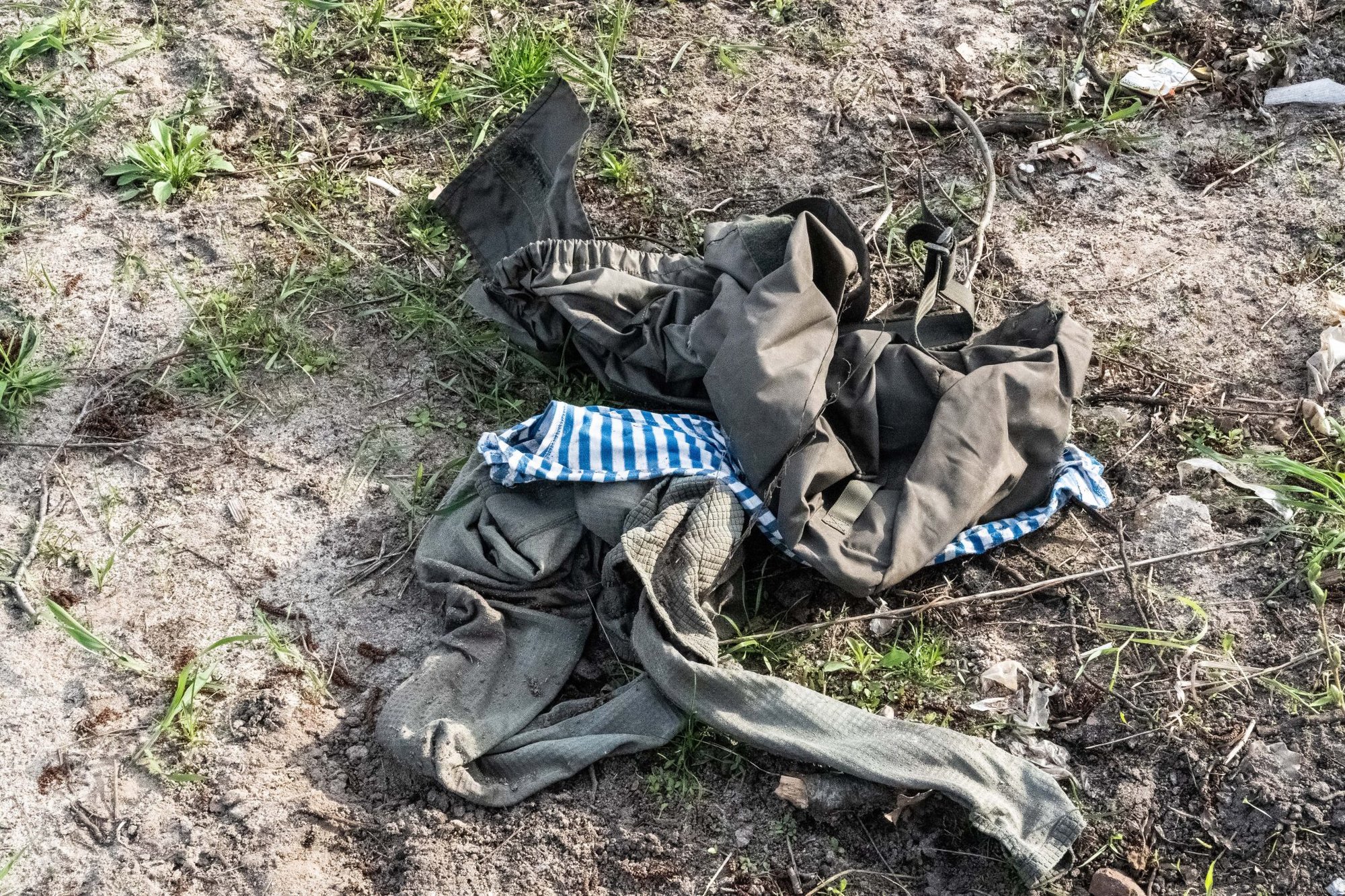
Fursa waited for a lull in fighting and then, with Olena beside her, gathered the courage to load into her car and make a thunder run for the Ukrainian lines. She activated her emergency flashers and gripped a crucifix as well as the steering wheel until her knuckles turned white. As she fled, Fursa prayed, “Dear God, please leave me some piece of my home to return to.”
On this day in late April, Fursa’s home is mostly intact, and evidence of the Russians’ aborted assault on Kyiv dots an adjoining field: torn-open ration boxes, bits of uniforms — including a green ushanka cap — and spent shell casings. Foxholes dug into the earth are filled with sleeping bags, blankets, and scattered food wrappers.
The sum result of Moscow’s desire to capture Kyiv, now reduced to these piles of rubble and waste.
“I had everything I wanted before the war,” Fursa says. “I had a beautiful home and gardens and nature. Then the Russians came and destroyed everything. They destroyed what I’d spent my whole life to build.
“But I will build it all again,” she says.
Read Next:

BRCC and Bad Moon Print Press team up for an exclusive, limited-edition T-shirt design!
BRCC partners with Team Room Design for an exclusive T-shirt release!
Thirty Seconds Out has partnered with BRCC for an exclusive shirt design invoking the God of Winter.
Lucas O'Hara of Grizzly Forge has teamed up with BRCC for a badass, exclusive Shirt Club T-shirt design featuring his most popular knife and tiomahawk.
Coffee or Die sits down with one of the graphic designers behind Black Rifle Coffee's signature look and vibe.
Biden will award the Medal of Honor to a Vietnam War Army helicopter pilot who risked his life to save a reconnaissance team from almost certain death.
Ever wonder how much Jack Mandaville would f*ck sh*t up if he went back in time? The American Revolution didn't even see him coming.
A nearly 200-year-old West Point time capsule that at first appeared to yield little more than dust contains hidden treasure, the US Military Academy said.












